
Who was Marcel Petiot? Marcel Petiot, a French doctor, gained infamy during World War II. Known as "Dr. Satan," he was a serial killer who lured victims with promises of escape from Nazi-occupied France. Instead of safety, they met gruesome deaths. Petiot's story is a chilling blend of medicine, murder, and mystery. His trial captivated France, revealing a man who exploited fear for personal gain. Why did he do it? Some say greed, others point to a twisted sense of power. How was he caught? A foul odor from his Paris home led to the discovery of human remains, unraveling his dark secrets.
Key Takeaways:
- Marcel Petiot, a doctor turned serial killer, lured victims with promises of safety during World War II, highlighting the dangers of trusting individuals during times of crisis.
- Despite his heinous crimes, Marcel Petiot's story continues to fascinate and horrify people, shedding light on the potential for evil in seemingly ordinary individuals.
Marcel Petiot: The Infamous Doctor
Marcel Petiot, a name synonymous with one of the most chilling chapters in French criminal history. Known for his heinous crimes during World War II, Petiot's life is a blend of mystery, deceit, and horror. Let's delve into some gripping facts about this notorious figure.
-
Marcel Petiot was born on January 17, 1897, in Auxerre, France. His early life showed signs of trouble, including expulsion from school for misbehavior.
-
He served in World War I, where he was wounded and gassed. His military service earned him the Croix de Guerre, a French military decoration.
-
After the war, Petiot studied medicine in Paris. He graduated in 1921 and began practicing as a doctor.
-
Petiot's medical career was marred by accusations of theft and fraud. He was even institutionalized for mental health issues but was released after a short period.
The Dark Side of Marcel Petiot
Petiot's life took a sinister turn as he delved deeper into criminal activities. His actions during World War II would cement his place in history as a cold-blooded murderer.
-
During the Nazi occupation of France, Petiot posed as a member of the French Resistance. He claimed to help Jews and others escape occupied France.
-
Petiot lured his victims to his home in Paris, promising safe passage to South America. Instead, he murdered them and stole their possessions.
-
He used quicklime and fire to dispose of the bodies, making it difficult to identify his victims.
-
In 1944, police discovered the remains of 23 people in Petiot's home. The actual number of his victims is believed to be much higher, possibly over 60.
The Capture and Trial
Petiot's capture and trial were as dramatic as his crimes. His courtroom antics and defense strategies were bizarre and shocking.
-
Petiot was arrested in 1944 after a manhunt that lasted several months. He was found hiding in a Paris Metro station.
-
During his trial, Petiot claimed he was killing Nazis and collaborators, not innocent people. His defense was filled with contradictions and lies.
-
The trial lasted from March 18 to April 4, 1946. It was one of the most sensational trials in French history.
-
Petiot was found guilty of 26 counts of murder and sentenced to death.
The Execution
The end of Marcel Petiot's life was as grim as the lives he took. His execution marked the conclusion of a dark chapter in French history.
-
Petiot was executed by guillotine on May 25, 1946. His last words were reportedly, "Gentlemen, I ask you not to look. This will not be very pretty."
-
His execution took place at La Santé Prison in Paris, a facility known for housing some of France's most notorious criminals.
-
Despite his heinous crimes, Petiot maintained his innocence until the end, insisting he was a patriot fighting against the Nazis.
The Legacy of Marcel Petiot
Petiot's story continues to fascinate and horrify people. His life and crimes have been the subject of numerous books, films, and documentaries.
-
The case of Marcel Petiot has inspired several books, including "Death in the City of Light" by David King, which provides a detailed account of his crimes.
-
Petiot's story was also adapted into a French film titled "Doctor Petiot" in 1990, directed by Christian de Chalonge.
-
His crimes have been the subject of various documentaries, shedding light on his manipulative and murderous nature.
-
Petiot's case remains one of the most infamous in French criminal history, often cited in discussions about serial killers and wartime atrocities.
Psychological Profile
Understanding Petiot's psychological makeup is crucial to comprehending his actions. His behavior exhibited traits of several mental disorders.
-
Petiot was diagnosed with various mental health issues, including kleptomania and pyromania, during his lifetime.
-
Some experts believe he exhibited signs of antisocial personality disorder, characterized by a lack of empathy and remorse.
-
His charm and intelligence allowed him to manipulate others easily, a common trait among psychopaths.
-
Despite his mental health issues, Petiot was highly functional, managing to maintain a medical practice while committing his crimes.
The Victims
The true horror of Petiot's actions lies in the lives he destroyed. His victims were often vulnerable individuals seeking help during a tumultuous time.
-
Many of Petiot's victims were Jews trying to escape Nazi persecution. They trusted him with their lives and possessions.
-
He also targeted other vulnerable groups, including resistance fighters and ordinary citizens desperate to flee occupied France.
-
The exact number of his victims remains unknown, as many bodies were never recovered or identified.
-
Families of the victims were left devastated, with many never knowing the fate of their loved ones.
The Investigation
The investigation into Petiot's crimes was complex and challenging. It involved multiple law enforcement agencies and spanned several months.
-
The discovery of bodies in Petiot's home led to one of the largest criminal investigations in French history.
-
Police initially believed they had uncovered a Gestapo execution site, given the number of bodies and the method of disposal.
-
The investigation revealed Petiot's elaborate scheme to lure and murder his victims, involving fake documents and secret rooms.
-
Petiot's arrest was a result of meticulous police work and tips from informants who had encountered him during his time in hiding.
The Aftermath
The aftermath of Petiot's crimes had a lasting impact on French society. It highlighted the dangers of trusting individuals during times of crisis.
-
Petiot's case led to increased scrutiny of individuals claiming to help refugees and resistance fighters during the war.
-
It also raised awareness about the importance of mental health evaluations for professionals in positions of trust, such as doctors.
-
The case remains a cautionary tale about the potential for evil in seemingly ordinary individuals.
-
Marcel Petiot's story continues to be studied by criminologists and psychologists, providing insights into the mind of a serial killer.
Marcel Petiot's Legacy
Marcel Petiot's story is a chilling reminder of how appearances can deceive. Known as "Dr. Satan," Petiot's heinous crimes during World War II shocked the world. He lured victims with promises of escape from Nazi-occupied France, only to murder them and steal their possessions. His trial in 1946 revealed the extent of his brutality, leading to his execution by guillotine.
Petiot's case remains one of history's most infamous examples of a serial killer hiding in plain sight. His ability to manipulate and deceive highlights the importance of vigilance and skepticism, even in seemingly trustworthy individuals. While his actions were monstrous, they also serve as a stark warning about the potential for evil within humanity.
Understanding Petiot's legacy helps us remember the victims and reinforces the need for justice and accountability in society.
Frequently Asked Questions
Was this page helpful?
Our commitment to delivering trustworthy and engaging content is at the heart of what we do. Each fact on our site is contributed by real users like you, bringing a wealth of diverse insights and information. To ensure the highest standards of accuracy and reliability, our dedicated editors meticulously review each submission. This process guarantees that the facts we share are not only fascinating but also credible. Trust in our commitment to quality and authenticity as you explore and learn with us.


